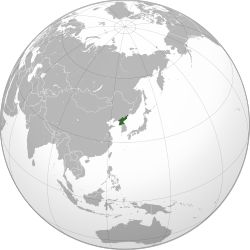 Location of North Korea (dark green) | |
| Medicinal | Likely not prescribed by doctors |
|---|---|
| Recreational | Illegal (but possibly often unenforced) [1] [2] [3] |
| Hemp | Legal [3] |
The legal status of cannabis in North Korea is unclear due to the lack of sources available to the outside world. Cannabis for industrial purposes (hemp), which has a low THC, is legal and is widely used in the country for the production of consumer goods. [3] As a result of the lack of reliable information on North Korea, myths suggesting the legal or widespread use of marijuana have been spread by some media outlets. [3] While officially illegal, there were reports in the early 2010s that authorities often do not enforce drug laws in relation to cannabis. [1] [2]
Contents
According to the Narcotics Control Law of the Democratic People's Republic of Korea (2005), cannabis and hemp resin is listed in Appendix 1 Narcotics, while enantiomers and stereoisomers of THC is listed in Appendix 2 Psychoactive substances with narcotic effects. [4]